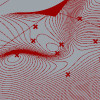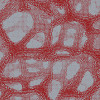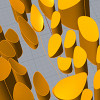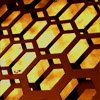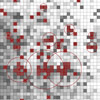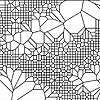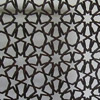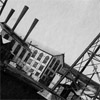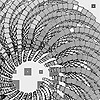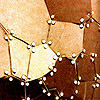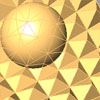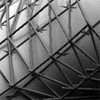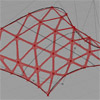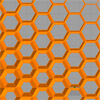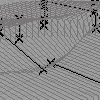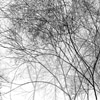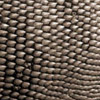Site models could be calculated for laser cutting easily using Grasshopper’s native components. This definition was a practical one we created in the Parametric Modeling course to see that Grasshopper could also be utilized to prepare fabrication documents not generating design outcomes. However, this definition is a draft one and could be improved more by putting labels inside of each cut piece, trimming the edges properly and so on. It is […]
Posts categorized under Parametric Modeling
Image Sampler of Grasshopper saves life if used responsibly. While explaining the component to this year’s ARCH362 students, I used this simple example that generates numbers from a beautiful picture of “metal foam” and uses it to generate lots of circles: Metal foams are lightweight but strong materials, that are typically produced by injecting gas into the liquid metal. Of course, it becomes easier to teach something when you manage […]
Another tutorial we’ve analysed together with ARCH362 students last week was the one that mimics Zaha Hadid’s Kartal Masterplan. Although the project of Zaha Hadid was pretty much controversial among Turkey’s architectural critics (and most people also), we’re not dealing with how successful or “ugly” it is, but the most simple version of the technique that generated such forms. We have a term “çakma” in Turkish that means “conscious imitation, possibly […]
This year’s Parametric Modeling class starts with some of the very basic use of Grasshopper concepts. This definition is a practical start-up of using force fields in the architectural design process. However it does not compute any physical phenomena (such as circulation of people, wind, or anything else), but shows a simple way to tell Grasshopper about walls that push the field, and points that pull the field. I’ll post more […]
Together with Fulya Akipek and Mehmet Ali Altın, we’re conducting a 4-day workshop at Anadolu University, Eskişehir, between the 1 and 4th of May. We’ll be focusing on Grasshopper + Firefly + RhinoNest (the casual trio), in order to introduce some of the basic concepts of parametric design to students. Materyal dünya, sayısal ortamın olanaklarıyla entegre edildiğinde beklenmedik performanslar açığa çıkabilir. Parametrik modelleme teknikleri, tasarımcıya tekil ürünün ötesinde olasılık setlerinin […]
Here is one of the student’s works from this semester’s parametric modeling elective course. We refer the first couple of hours in molding of concrete as its “alive” phase. During this phase, due to various reasons concrete sweats, respires and in a way contains an inner circulation of forces. This phase ends when concrete dries and hardens, creating a kind of its fossil. Air bubbles are frozen inside and some even are seeable from on […]
This was the initial example of image processing in our Parametric Modeling class. I saw this design on Maxthreads Architectural Design’s website (especially here). Hand-drawn and digital diagrams can also be digitized and used in order to describe certain parameters for design formation. Such algorithms would similarly use the Image Sampler Component of Grasshopper. In the algorithm below, image data is used to capture black pixels as attractors of a Voronoi subdivision. […]
This was my first parametric patterning study we conducted together with Birgül Çolakoğlu at Yıldız Technical University in 2008. It was based on the pattern exercises we’ve experienced with BOT Graduate Students as a preliminary study within a Computational Design Studio. Later, the CNC fabrications were exhibited at İstanbul Bilgi University Digital Design Symposium. The exercise was about analyzing and reconstructing regular İslamic Patterns via MaxScript. After fundamental instructions about the […]
ARCH 362 COURSE BRIEF (2013) Design computing reflects a focal shift from the singular construction of objects into the relational nature of revealing diversity. Algorithms are mainstream interfaces for the explication of geometric relationships, extending techniques required for such revealing. This course introduces some ways of managing diversity while reasoning about sequential and concurrent; absolute and relational; ordered and chaotic. Students are expected to be familiar with fundamentals of Rhino3D, […]
A newly established student club, “E3 Architecture and Design” is organizing a two-day workshop at İstanbul Bilgi University Faculty of Architecture between June 10-11, 2013. The Grasshopper Workshop will be the first one in the faculty. The event will be conducted at our computer lab. so the seats are limited to 28. I’ll try to explain the basic concepts of dataflow management in computer-aided design. Also, I plan to test […]
The “Re_Flex Patterning” workshop will be conducted at İzzet Baysal University Faculty of Engineering and Architecture between 6-8th May 2013. The workshop is led by Tuğrul Yazar and Fulya Akipek, from the İstanbul Bilgi University Faculty of Architecture. Integrating digital media with the material world reveals emergent performances. Parametric modeling techniques encourage designers to study more on the envelopes of potentials instead of singular artifacts. Working with these envelopes tells […]
Today, we’ve finished first phase, the introduction to dataflow management in visual programming environments; and conducted “well defined” part of the mid-term examination. First two questions were designed to test technical skills of data matching, geometric evaluation. First one was a simple algorithm that calculates the area of ANY triangle in real-time. Tricky part of this problem was to research and find ways of calculating area and implementing it in […]
Here are some results of fourth homework. An animate design sketch of a roof structure. Yağız, Deniz and Sacha created animated results; Derya and Sacha proposed conventional approaches to create “openings” by animating geometries. However, that does not meet the requirement of structural (and logical) intentions of the design problem. Unless some very high-tech materials were introduced to design. On the other hand, Yağız tried to create a structure that […]
After a reviewing a short story of digital architecture from Branko Kolarevic, we looked at the roots of the theory and the concepts derived from it such as digital fabrication, building information modeling and parametric modeling. After a short brief, we’ve discussed about the final projects. Next week, we’ll start studying final projects and start to look at individual problems developed from them. Final submissions will highly be related with […]
Today, we’ve studied fundamentals of component-based design methods. Using curves and surfaces as starting points, we’ve experienced ways of translating those entities via design criteria based on our purposes. First, a curve is used to construct a leaf structure. We’ve experienced dispatching data lists and combining them back together. Subdividing curves into points created further entities such as vectors and planes. We used those entities as inputs of regular drawing […]
Today’s subject was closely related to the one last week; the data list and data tree management. Creating suitable data structures for our purposes is one of the tricky parts of whole Grasshopper experiments. We’ve developed a grid of objects, somehow associated with another one (a curve). Strong emphasis was on the way of thinking, getting back and forth on the process, and the re-definition of data lists. Especially, this […]
SPEC disappeared from our garden suspiciously. Hopefully, we’ve already finalized its parametric survey. Can create the original model by measuring exact corner coordinates. Then, it manipulated shape by creating diverse vectors for each shape. Emre has also tried a similar approach. Can be definition was too long, and did not use data trees, therefore it is slow. But it’s very effective at offering a solution for animation. I re-captured his […]
Today, we’ve studied ways of representing multiple data structures in Grasshopper. As of our last week’s experience, sometimes (most of the time actually) we’ll need to work with vast amount of data. We’ll have to control them in order to open door for further explorations. Today’s exercise was a good example of this “sustainable” process of data management. All functionality of Grasshopper is based on data matching. From short-list, long-list […]
Here are some of the results of first assignment, “Reptile Skin”. Generally, we couldn’t manage to develop innovative solutions to the problem. But this became a good starting point for understanding the method of “skins of components” in contemporary digital design. Before going into any control over the flow of data, it’s hard to maintain associative geometries. We usually feel stuck within the capabilities of the single commands or procedures. […]
ARCH 362: PARAMETRIC MODELING: Undergraduate Elective Course at İstanbul Bilgi University Faculty of Architecture student exercise: Deniz Yazıcı (YTU/CADU 2008) COURSE BRIEF (2011) Digital paradigm transferred parametric modeling as an alternative conception in architecture, emphasizing a focal shift from the singularity of design artifacts to the explicit and generative process of designing. While architects start to experience the construction of algorithms, computers played an increasingly important role in the adaptation of […]

